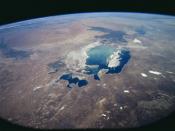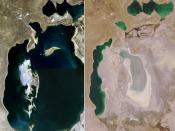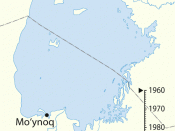Desiccation of the Aral Sea
THE SITUATION
The Aral Sea in the former USSR, the CIS, formerly the world's fourth largest lake in area, is disappearing. Between 1960 and 1987, its level dropped 13 meters, and its area decreased by 40 percent. . Severe environmental problems have resulted. The sea could dry to a residual brine lake. Local water supplies where in disirae. Schemes to save parts of the sea have been proposed by the government. Nevertheless, in this case study I will explain the problems and hopefully conclude with a solution.
THE PROGRESSIVE PROBLEM
The Aral Sea is a huge, shallow, saline body of water located in the deserts of the south-central CIS. It is called a terminal lake (having no outflow), its level is determined by the balance between river and ground-water inflow and precipitation on its surface on the one hand and evaporation from the sea on the other.
The Aral depression has repeatedly been flooded and desiccated. Until the present century, fluctuations in its surface level were at least 20 m and possibly more than 40 m. Significant variations of sea level during this period resulted from major changes in river discharge into it caused by climatic changes, by natural diversions of the Amu Dar'ya away from the Aral, and by man. Human impacts included big withdrawals for irrigation from the Amu Dar'ya and diversions of this river west into lower lying channels because of the destruction of dikes, dams, and irrigation systems during wars. From the middle 18th century until 1960, sea level varied 4 to 4.5 m. Beginning in 1910, when accurate and regular level observations began, to 1960, the lake was in a "high" phase with level changes of less than 1 m. However, during the past 28 years the sea's surface has...



Interesting, well-written but flawed conclusions
This is a well-written essay and discusses the problems of the Aral Sea and their causes fairly well. The proposed solution is unfortunately deeply flawed, not only from a cost-benefit analysis but also because the level of the Caspian Sea is roughly 75 feet below that of the Black Sea and about 200 feet below that of the Aral. Still, a worthwhile submission and with a bit of editing, a great one.
2 out of 2 people found this comment useful.